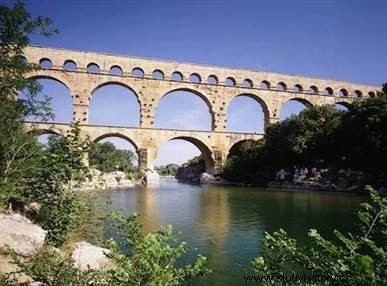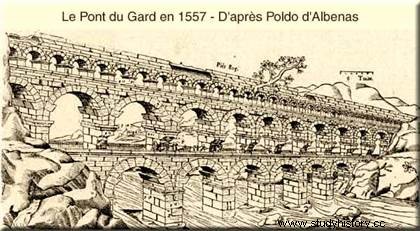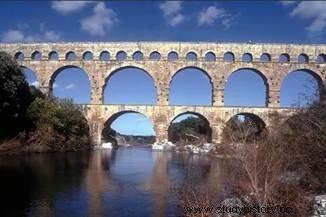 Located above the Gardon, near Nîmes, the Pont du Gard is the highest of the Roman aqueducts and one of the greatest achievements of Roman architecture in France. Great monument classified as a Major Monument in 1840 by Prosper Mérimée, registered as a Historic Monument since 1913, admitted to the UNESCO World Heritage in 1985, it was only a simple utilitarian construction at the time of the Roman Empire. Built in limestone in the first half of the 1st century BC. AD, it consists of three rows of superimposed arcades of Tuscan order. Powerful and solid, having suffered the winds, floods when the water rose to the second level, wars and industrial evolution, it still stands.
Located above the Gardon, near Nîmes, the Pont du Gard is the highest of the Roman aqueducts and one of the greatest achievements of Roman architecture in France. Great monument classified as a Major Monument in 1840 by Prosper Mérimée, registered as a Historic Monument since 1913, admitted to the UNESCO World Heritage in 1985, it was only a simple utilitarian construction at the time of the Roman Empire. Built in limestone in the first half of the 1st century BC. AD, it consists of three rows of superimposed arcades of Tuscan order. Powerful and solid, having suffered the winds, floods when the water rose to the second level, wars and industrial evolution, it still stands.
The construction of the Pont du Gard
The Pont du Gard, the most famous ancient aqueduct in the world, is located twenty-one kilometers from Nîmes and Avignon, in the town of Vers-Pont-du- Gard. Like all Romans, the people of Nîmes loved water. They also needed it for their personal comfort, as well as for baths and fountains. An aqueduct was then built between the 1940s and 1960s under the reign of Claude and Néron, to bring water from the source of Uzès fifty kilometers away. The Pont du Gard is only one piece of this aqueduct, the rest of the route being buried on almost ninety percent of the structure.
This airy bridge spans the Gardon over a length of two hundred and seventy-five meters and over three levels of arches. At the first level at a height of twenty meters, six arches are visible. The second level of the same height has eleven arches and the last level has forty seven, smaller on a height of about eight meters. The water circulated on this third level in a channel one meter and twenty wide, with an average slope of twenty five centimeters per kilometer, the flow being thirty five thousand cubic meters per day on average and the water thus took twenty six hours to connect Uzès to Nîmes.
The stones were extracted from a quarry close to five hundred meters, a coarse-grained light yellow limestone, stuffed with fossils of small shells (the stone is still used today for the ornament of dwellings), in blocks of six tons for some, loaded on ox carts, then moved on wooden rollers. The construction of this work weighing approximately fifty thousand four hundred tons, required a thousand men for fifteen years, before being fully operational after twenty.
It's a real masterpiece of construction:set on a rock, the piles on the first floor are two meters sixty wide and are equipped with front spouts to resist to the floods of the Gardon. Everything is assembled without mortar, the stones scraped on top of each other, until the perfect positioning.
The evolution of the aqueduct
 During the second and third centuries, the aqueduct functioned optimally. You cross the bridge either on the three meter fifty wide walkway on the first floor, or on a one meter passage on the second floor. But from the fourth century, it is no longer maintained and is only used to water agricultural land. Abandoned completely in the sixth century, it became unusable in the ninth and the people came to recover the stones for their homes or for other constructions.
During the second and third centuries, the aqueduct functioned optimally. You cross the bridge either on the three meter fifty wide walkway on the first floor, or on a one meter passage on the second floor. But from the fourth century, it is no longer maintained and is only used to water agricultural land. Abandoned completely in the sixth century, it became unusable in the ninth and the people came to recover the stones for their homes or for other constructions.
In the Middle Ages, the bridge was the most important passage to reach the great fair of Beaucaire, but paying:the lord of Uzès recovered about the equivalent of four one hundred and fifty euros. By the sixteenth century, the cost of passage had more than doubled.
But as these crossings progressed, the bridge began to shift. In 1699, the intendant of the province asked for work to be carried out…another bridge was built over the Gardon in 1745, leaning against the eastern facade of the aqueduct. So you could admire the aqueduct from afar without damaging it.
Finally, thanks to Napoleon III, real repairs were undertaken between 1853 and 1857, and the following inscription was affixed:
THIS AQVFDVC BUILT BY THE ROMANS
TO CONVIDE THE EAVX OF LA FONTAINE D'EVRE IN NIMES
REPAIRED BY LANGVEDOC STATES IN MDCCII
WAS CONSOLIDATED AND RESTORED TO MDCCCLV
BY THE ORDERS OF EMPEROR NAPOLEON III
AND BY CARE OF THE MINISTER OF STATE
CH. QVESTEL AND J. LAISNÉ ARCHITECTS.
The writers have honored this beautiful work which will remain forever and which we discover at the bend of a bend. Like Alexandre Dumas who wrote “I have never seen anything so beautiful, so grand, so Virgilian as this magnificent granite epic called the Pont du Gard”. Let's not forget Stendhal "you know that this monument, which was only a simple aqueduct, rises majestically in the middle of the deepest solitude:the soul is thrown into a long and deep astonishment. There is no appearance of luxury and ornament there. The Romans did these amazing things, not to inspire admiration, but simply when they were useful”.
The Pont du Gard site nowadays
Twenty thousand years ago, the Pont du Gard site was inhabited. After acceptance as a UNESCO World Heritage Site in 1985, researchers began excavations and discovered fossils, statue-menhirs, ancient habitats near the river. The three caves are classified as World Heritage:the Balauzière cave, the Salpêtrière cave and the Sartanette cave.
 Visitors are coming in increasing numbers, and walk around the first floor of the Pont du Gard. But it is also necessary to carry out external installations:the operation was launched in 1996 in order to set up spaces of knowledge and discovery with a course on “the memory of the garrigue”, after four years. A museum of Romanity is installed there on two thousand five hundred square meters and a film is projected on the history of the Pont du Gard.
Visitors are coming in increasing numbers, and walk around the first floor of the Pont du Gard. But it is also necessary to carry out external installations:the operation was launched in 1996 in order to set up spaces of knowledge and discovery with a course on “the memory of the garrigue”, after four years. A museum of Romanity is installed there on two thousand five hundred square meters and a film is projected on the history of the Pont du Gard.
From July 1 to August 31, each year, visitors who exceed the annual million, can enjoy the freshness of the waters of the Gardon with the "Pont du Gard Plage" where rafts are installed at the water's edge.
To go further
- The Aqueduct of Nîmes and the Ponts du Gard:Archaeology. Geosystem. History, by Guilhem Fabre. CNRS, 2000.
- The Pont du Gard and the Roman aqueducts, by Frédéric Cartier-Lange. Alcide Youth, 2018.
